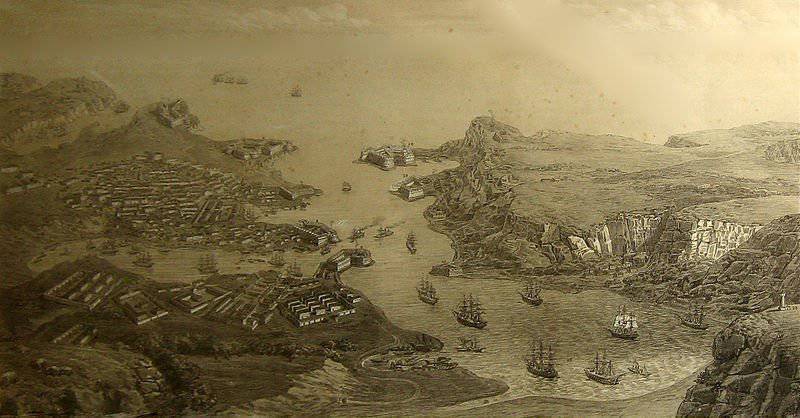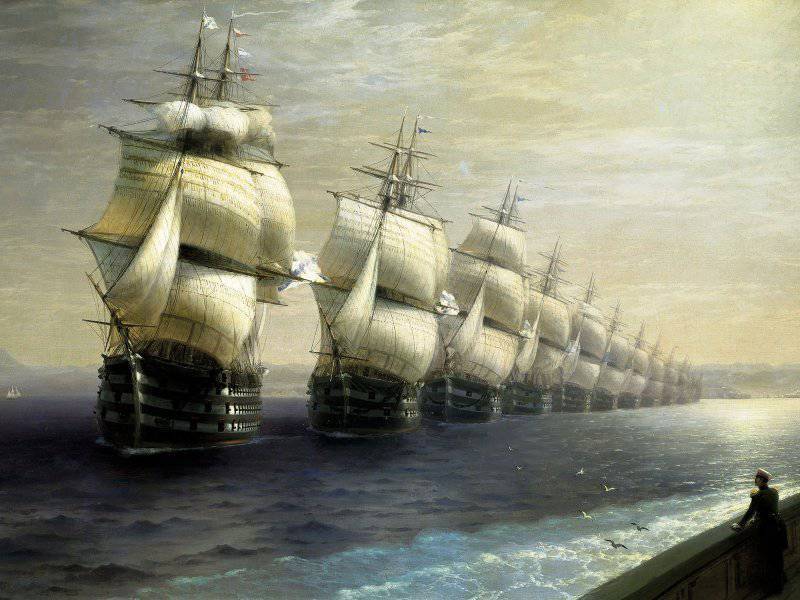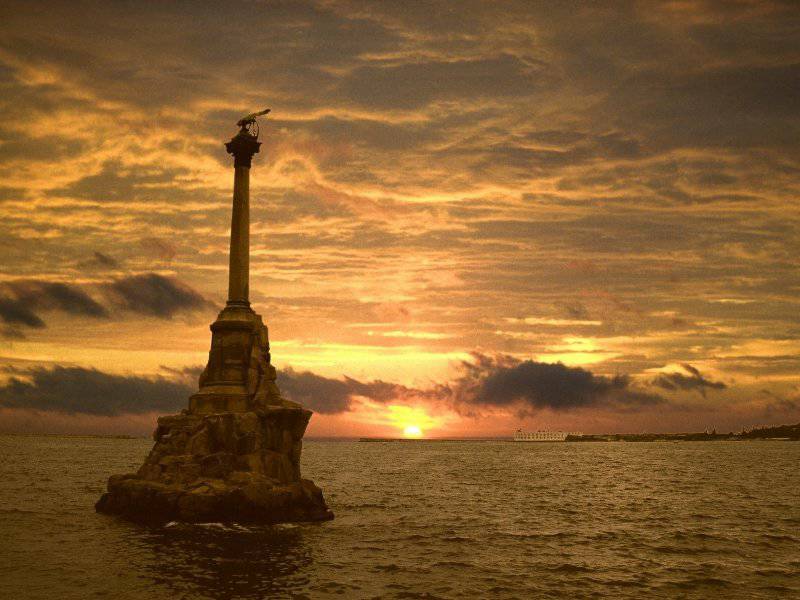The birth of the city of Russian glory

In 1686, the war began with Turkey, which was marked by repeated campaigns against the Crimean khans. In 1695, Russian troops first captured Perekop fortress, but soon it was again in the hands of the Tatars. In 1700, Peter I managed to conclude a profitable peace treaty with Turkey, according to which Russia gained access to the southern seas. This did not please the Western countries, which sought to remove our armies from the Baltic lands. Their ambassadors appeared in the Ottoman Port, inclining the Sultan to war. Their plan was a success only by 1710-th year. During the unsuccessful hostilities, our country again lost access to the Black and Azov Seas.
Only in the 1736 year did they manage to take revenge. Count Christopher Minich captured Perekop, and a year later Petr Petrovich Lassi completed the defeat of the Crimean Khanate by wading into the rear of the Sivash Khan, waiting for our troops from Perekop. Soon the Crimean peninsula was completely captured by the Russians. However, Austria, the former ally of Russia, suffered a series of defeats and withdrew from the war. This, as well as the deterioration of relations with Sweden, forced our state to conclude with Turkey in the 1739 year in Belgrade unfavorable peace treaty, under which she was deprived of most of the territorial gains and access to the Black Sea.
The precarious balance between war and peace on the Crimean peninsula lasted almost thirty years. With the tacit approval of the Turkish authorities, the local Tatars plundered and burned the neighboring Russian lands, and Catherine II, who was engaged in other problems, for the time being did not apply decisive measures to them. In 1768, Turkey, again instigated by England and France, declared war on our homeland. In 1771, Russian regiments led by Dolgorukov, having destroyed the enemy at Perekop, entered the Crimean peninsula. Having lost all their fortresses, cunning Tatars declared themselves independent of the Ottoman Empire and asked for the patronage of Russia. A number of brilliant victories won by Rumyantsev and Suvorov, as well as the death of the Turkish flotilla in the Chesme battle, the Great Port was forced to sign the Kuchuk-Kainardzhi Treaty in 1774, which put an end to the fighting. The Crimean Khanate finally gained independence from Turkey, and Russia gained vast territories of the northern Black Sea coast. From now on, Russian ships could freely travel across the expanses of the Black Sea. But, despite the peace agreement, the Ottoman Empire did its best to change the result in its favor, pushing the Crimean Tatars to revolts and riots. For eight years, Russia fought for its approval on the peninsula.
In the early spring of 1778, Alexander Suvorov was appointed to command all the troops of the Crimea and Kuban. Already in May, he arrived with a tour of the bay near the small Tatar village of Ak-Yar (which means “White Rock”) near Kherson. The bay was surrounded by hills with steep, steep slopes overgrown with shrubs and low forest. The famous commander immediately appreciated the value of the Bay of Akhtiar. Stretching for many miles with a deep water area allowed the ships to come very close to the coast, the size of it could accommodate the largest fleet, and the surrounding mountains reliably saved ships from the storm whirlwinds. Suvorov wrote in his papers: “Such a harbor is not found not only near the local peninsula. On the whole Black Sea there is no place where the fleet would be better preserved, and the employees on it will be quieter and more comfortable placed ... ”.
Turkish admirals also understood this well. Contrary to the Kyuchuk-Kainarji peace treaty, the Ahtiar Bay was guarded by ten of their ships. By this time, the Turkish government was openly preparing for revenge and even sent three squadrons into the sea. Catherine II gave the order to prevent the landing of the landing, not taking any military action first. This dual task was assigned to Suvorov, who had already distinguished himself in a number of magnificent victories over the Turks in previous years. First of all, Alexander Vasilyevich decided to take up their ships in the Akhtiar Bay, rightly believing that the squadron’s departure would be the solution to all problems. However, he could not find a peaceful way to oust the enemy flotilla from the port of Suvorov for a long time, until he was helped by chance.
7 June 1778 of the year in a casually ensuing fight by Turkish sailors killed the Don Cossack. The commander of the Crimean Corps demanded that the captains of the Turkish courts find and punish the murderers. He was answered with assurances of eternal love and friendship, at the same time making it clear that the guilty would not be punished. Then Alexander Suvorov decided to use this precedent for the implementation of a long-thought-out military diplomatic action. Under his order, on the night of June 14, six infantry battalions on both sides of the bay entrance began to build artillery batteries. The positions chosen by the Russian genius made it possible to cover with fire the departure of any ships from the raid.
Admiral Haji-Megmet, who led the Turkish squadron, was very surprised to see the contours of the earthen parapets built overnight. On the same day, he turned to Alexander Vasilyevich for an explanation and almost immediately received a letter from him in which Suvorov spread about his peace-loving intentions and respect for the naval commander ... Over the next night, the outlines of the batteries grew significantly, and the Turkish admiral, afraid to be trapped , ordered to immediately leave the bay. For almost two weeks, frigates sailed in coastal waters, and then retreated to Sinop. So, on the local shores, the first fortifications appeared, and Suvorov received a gold snuffbox from the empress, strewn with diamonds.
By this time there was an active development of the Black Sea lands, which had ceded to the Russian Empire as a result of the Kyuchuk-Kaynardzhi Treaty. In the 1775 year, they, along with a number of places from the steppe Ukraine, became part of Novorossia, and at that time the all-powerful favorite of the Empress was in charge of all affairs, Prince Gregory Potyomkin, her deputy. Energetic and persistent, he was distinguished by the ability to find business and enterprising assistants. For the development of desert and wild territory, he organized the resettlement of peasants from the central provinces, as well as runaway workers. From Europe, the French, Germans, Italians, Poles, Austrians, Jews and other foreigners, seduced by the fertile black soil and privileges of the Russian government, reached here. New cities were laid and grew: Stavropol, Aleksandrovsk on the Dnieper, Yekaterinoslav. For trade with other countries increased the port of Taganrog.
But in order for Russia to feel confident on the Black Sea, it was necessary to create a powerful navy. Already in the 1774 year, by decree of Catherine II, a suitable place was found in the Dnieper estuary for the construction of a harbor and two dozen slipways needed for the construction of warships. Thus, in 1776, the capital of Novorossiya, the city of Kherson, was founded. Here was the office and residence of the governor of the empress, as well as the Black Sea Admiralty Department formed. Under his command were all the naval forces of the Black, Azov and Caspian seas. And on the stocks, located on the banks of the Dnieper and Desna, built new ships.
At the beginning of 1783, Fedot Alekseevich Klokachev was appointed commander of the emerging Black Sea Fleet, who had previously led the Azov squadron. And soon he received an order to explore the Akhtiar Bay in order to create a naval base there. His flotilla began to prepare for the campaign. And soon came a decree of Catherine II on the inclusion of the Crimea, called the Tauride province, into Russia. Tavrida or the Crimean peninsula was also placed under the control of Grigory Potemkin, christened by the Most High Prince of Tauride. Already in April, a grenadier battalion was stationed on the shores of the bay of Akhtiar, followed by the Koporsky and Dneprovsky regiments, as well as artillery units. And on May 2, the squadron of Vice Admiral Klokachev, consisting of five frigates and eight other ships, came to Akhtiar raid. A few days later, Fedot Klokachev sent a report to the Naval Minister: “... Already at the entrance to the Akhtiyar harbor, I marveled at its good position from the sea, and after entering and looking around, I can say with confidence that there is no such harbor in all of Europe - size, position and depth . It can accommodate a fleet of up to hundreds of linear ships, moreover, nature itself arranged estuaries, which are divided into different harbors, that is, merchant and military ... If Imperial Majesty will be pleased to have a fleet in the local harbor, then it will be necessary to start a port here, like Kronstadt.

7 May 1783-th year in the Bay of Ahtiar arrived eleven more ships from the Dnieper Flotilla. From that moment on, all naval forces in the south of Russia became known as the Black Sea Fleet. The combination of vessels from different squadrons in the Akhtiar roads did not happen by chance. In the capital of the empire for a long time they collected information about this bay and made far-reaching plans for it. Back in the 1773 year, before the inspection of the Suvorov Bay, the navigator Baturin, who arrived here from the ships overwintering in Balaklava Bay, made the first terrain plan. And even earlier, the government of our country had information about it from foreign seamen and scouts.
8 May 1783, the Vice-Admiral Klokachev went to Kherson to take over the leadership of the entire fleet. Instead of himself commanding the squadron standing on the Akhtiar raid, he left Rear Admiral Thomas Mekenzi. Under his leadership, sailors, soldiers, and several local Greeks, who were masters of stone, lost no time in laying a canopy, a forge, a chapel, and a stone house for the highest authorities on the canopy of the headland. Later this cape was named after St. Nicholas. At the same time, small houses were built from nearby materials on nearby hills. They settled family sailors, as well as the first settlers. The gunners built several earthen redoubts that protected residential buildings from the sea and defended the places suitable for the landing. The batteries of Suvorov at the entrance to the raid were expanded and strengthened.
Initially, only the material that was in the area was used. The stone was mined from the ruins of Chersonesos, clay and sand were from the shores of the bay, and shrubs from low growth forests were nearby. Soon came the first carts with wood, iron and other necessary materials. According to the Mekenzie report, the work was done sporably and amicably, and already in July the construction of a small admiralty, barracks and warehouses was completed. In August, a blacksmith shop was commissioned, a chapel was consecrated, and on November 1, 1783 of the year passed a ball dedicated to the completion of work and a squadron commander's housewarming and naval officers in stone houses. Russian sailors settled in Akhtiar Bay seriously and for a long time.
In the same year, Turkey documented Russia's rights to the Kuban, Taman and Crimea. And soon Prince Potemkin from the northern capital came Catherine II's rescript from February 10 (February 21 in new style) 1784 of the year: “... With the spread of the borders of the All-Russian Empire ... to appoint new fortresses for convenience ... Where is Ahtiyar to build a great Sevastopol fortress with the Admiralty, the shipyard for ships of the first rank, the port and the military village ... ". Sevastopol, like other cities of the “annexed land” (Alexandria, Simferopol, Stavropol, Melitopol), received the name in the ancient Greek manner because of the desire of Catherine II to build on the Black Sea coast a similarity to the Constantinople Empire. In honor of the founding of the city in the capital produced a commemorative medal. The name of the new stronghold initially defined its role for the Fatherland. From the Greek "Sevastopol" means the holy city or city worthy of worship. Russia wanted to see him that way, he will become like that in the future ...
Twelve days after this rescript, a wise decree of the empress followed, proclaiming Sevastopol open for trade. In the Artillery Bay erected a pier and warehouses. Merchants and artisans rushed to the city, various working people came for permanent residence. The flow of goods and building materials grew, as did the settlements around the South Bay. Sevastopol squadron also increased, supplemented with new ships. In the autumn of 1784, the seventy-cannon battleship "Glory to Catherine" arrived here, and a year later the "St. Paul" joined him, under the command of the legendary Ushakov. By the 1785 year, a large part of the ship and rowing Black Sea Fleet was based in Sevastopol.
A huge role in the construction of Sevastopol in the early years was played by teams of local squadron ships. Fyodor Ushakov, always smart and energetic, personally gave assignments to officers and sailors of St. Paul who took part in the construction of many barracks, warehouses, stone outbuildings, and even planting acacias, chestnuts, and apple trees. He also did not forget about the maritime business, having achieved that his crew became the first in the training squadron. In 1788, he was appointed commander of the Sevastopol squadron and port, continuing the active construction of the city.
In February, the 1784 of the year the Russian government allowed free trade in Sevastopol to both foreign and local merchants, bringing goods by sea or land routes. The construction of a powerful new fortress and a naval base provoked a protest from Turkey, which was supported by the British and the French. Around the "Crimean Question" was deployed a whole diplomatic struggle that lasted for many years. Given the difficult international situation, in order to demonstrate Russia's readiness for the battles on the Black Sea, Catherine II even made a trip to Tauris. In May, her retinue 1787 was struck by a mighty fleet lined up in the bay of Sevastopol. Twenty-seven new military ships and eight transports greeted guests with gunfire. The solemn review of the squadron ended with a demonstration of the “attack” by the fleet of the northern side of the bay. One of the French envoys who accompanied Catherine II recorded that day: “I am afraid that soon the flags of her ships (empresses) will fly near Constantinople, and the banners of her armies will be erected on its walls.” After the death of Empress, Paul I ordered his mother to rename Sevastopol to 1797 in the year Akhtiar. The former name was returned to the city only in the spring of 1826 by the decree of Nicholas I, which ended as follows: "... so that the city will never be called Ahtiar, but always Sevastopol."
• In 1843, in Sevastopol, the construction of the largest in Europe Nikolaev coastal battery with casemates for two hundred guns was completed. Its length was 460 meters.
• At the end of the XNUMXth century, there were three oyster factories in the city, which the court of the Imperial Majesty preferred to the popular Italian and French ones. Especially for the delivery of these delicacies to the Northern capital of the Fatherland, the country's first railway car equipped with a refrigeration unit was built.
• In 1893, a pigeon mail station was established in the Sevastopol fortress, which included about 250 birds.
• On October 29, 1955, the battleship Novorossiysk exploded in the Sevastopol Bay. It was the largest disaster in the Black Sea in peacetime.
• In 1931, the world's first wind farm was built in the vicinity of Sevastopol.
• In August 1899, it was in the Sevastopol Bay that the world's first radio communication between warships was established. Popov's experiment was attended by "George the Victorious", "Three Saints" and "Captain Saken".
• At 3 am on June 22, 1941, the anti-aircraft artillery of the city was the first in the USSR to start a battle with Nazi aircraft. Thanks to anti-aircraft gunners during the first raid, not a single ship was lost.
• Near Sevastopol there is a reserve command post of the Red Banner Black Sea Fleet, built in 1979-1992, which is the largest underground structure in the Crimea.

Today, Sevastopol is still the main base of the Russian Black Sea Fleet (according to the agreement with Ukraine extended to 2042), although its former strength remained only in the memories. However, Sevastopol is not only a port. Nowadays, the tourist component is rapidly developing here, which in the future may become the main purpose and economic foundation of the Hero City. On the territory of Sevastopol you can find many unique cultural and historical monuments. And the beautiful sea washing the shores of the city-defender, magnificent landscapes and attractive beaches attract travelers from all over the world.
Information sources:
-http: //ru.wikipedia.org/wiki/
-http: //www.country.alltravels.com.ua/ru/ukraine/sevastopol/sight/history-sevastopol/
-http: //gpristan.com/istoriya-sevastopolya
-http: //www.razlib.ru/istorija/sevastopolskaja_krepost/p3.php
-http: //www.sevastopol.org/hist1.htm
-http: //www.vostlit.info/Texts/Dokumenty/Russ/XVIII/1780-1800/Osnov_Sevastopol/text.htm
Information